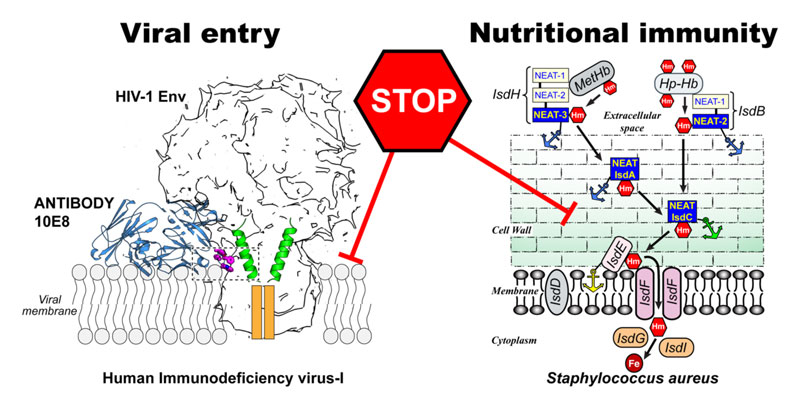#PDD#
Protein
Drug
Discovery
COVID-19のパンデミックは私たちに感染症に潜む危険性を再認識させました。さらには、こうしたパンデミックに対する政治的・科学的な脆弱性が露呈したと言うこともできます。当研究室では感染症に対する次世代の治療戦略の構築を目指し、感染症の感染経路に関わる蛋白質やその感染経路を遮断する薬剤の開発研究を行っています。一例として、抗HIV-1広域中和抗体に対して部位特異的な化学修飾を施すことによってその中和活性を1000倍向上させる技術開発が挙げられます。また、既存薬に対する耐性菌の出現が問題視されている黄色ブドウ球菌や化膿連鎖球菌といった病原性微生物を標的とした研究も実施しています。これらの病原菌は、菌の生育に欠かせない鉄原子の供給源として、宿主細胞からヘム分子を奪取する蛋白質分子キャスケードを構築しています。当研究室ではこのヘム奪取の主役となる蛋白質に着目して機能解析を進めている他、その蛋白質の機能を阻害する低分子化合物や抗体の開発研究を推進しています。その様な化合物や抗体は次世代の抗菌薬開発の端緒を与えると期待されます。
The latest COVID-19 pandemics has reminded us of the latent dangers of infectious diseases. It has also revealed the insufficient preparedness of civil authorities and scientific communities. In our laboratory we investigate various pathways that, if properly blocked, could be employed as a next generation therapeutic strategy against various infectious diseases. For example, site-specific chemical modification has been employed to increase the potency of anti-HIV-1 broadly neutralizing antibodies by up to 1,000-fold. In another example, to fight the antibiotic-resistant bacteria Staphylococcus aureus and Streptococcus pyogenes we are focusing on protein systems capable of “stealing” the nutritional compound termed heme containing an atom of iron. By understanding the basic biological mechanism, we can focus on the most susceptible proteins that will subsequently be subjected to drug-discovery campaigns with small molecules and generation of specific antibodies, with blocking capabilities. These compounds and antibodies will become novel antimicrobial and in favorable cases may enter clinical trials.

